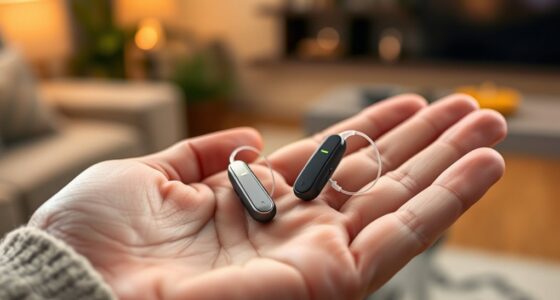Personal FM systems are a game changer in classrooms because they deliver your voice directly to students’ hearing devices, cutting through background noise. This helps students hear clearly, stay engaged, and participate confidently. They also reduce listening fatigue and create a more inclusive environment for all learners. By choosing the right system and properly implementing it, you can greatly enhance your teaching experience and student success. Keep exploring to discover how to make the most of this technology.
Key Takeaways
- Personal FM systems improve speech clarity in noisy classrooms, enhancing student comprehension and participation.
- They create a consistent audio environment, reducing listening fatigue and increasing focus for students with hearing challenges.
- Easy-to-use, compatible devices foster inclusive learning, supporting better social interactions and academic performance.
- Proper implementation and maintenance ensure reliable connection, maximizing the system’s positive impact on classroom communication.
- Success stories show that FM technology boosts student confidence, engagement, and overall learning outcomes.
How Personal FM Systems Work in Educational Settings

Personal FM systems enhance communication in educational settings by directly transmitting a teacher’s voice to a student’s hearing device. They achieve this through wireless connectivity, allowing the microphone worn by the teacher to send audio signals to the student’s compatible listening device. This wireless connection reduces background noise and guarantees clear, focused sound delivery. Device compatibility is essential; the FM system must work seamlessly with the student’s hearing aids or cochlear implants, often through compatible receivers or accessories. Once set up, the teacher’s voice is transmitted directly to the student, providing consistent and reliable audio. This technology simplifies interaction, minimizes misunderstandings, and creates a more inclusive learning environment for students with hearing difficulties.
Benefits of Using Personal FM Devices for Students

Using Personal FM devices offers students with hearing difficulties a significant advantage by improving speech clarity and understanding. This auditory enhancement helps students focus on conversations without competing noise, making it easier to follow lessons and participate actively. As a result, student engagement increases because students feel more connected to the teacher and their peers. Personal FM systems also reduce listening fatigue, allowing students to concentrate longer and process information more effectively. When speech is clearer, students experience less frustration and are more likely to stay attentive during lessons. Overall, these devices create a more inclusive classroom environment, empowering students with hearing challenges to learn confidently and comfortably. The benefits extend beyond hearing, positively impacting academic performance and social interactions. Additionally, utilizing personal FM systems aligns with best practices in inclusive education, ensuring all students have equitable access to learning.
Choosing the Right FM System for Your Classroom

Choosing the right FM system for your classroom guarantees that students with hearing difficulties receive the maximum benefit. To do this, consider wireless connectivity options and device compatibility. Confirm the system seamlessly connects with various devices like tablets, laptops, or hearing aids. Compatibility issues can hinder learning, so verify that the FM system works with your existing technology. Here’s a quick comparison:
| Feature | Important Considerations |
|---|---|
| Wireless Connectivity | Look for systems with reliable, secure connections |
| Device Compatibility | Confirm compatibility with your devices and hearing aids |
| Ease of Use | Select a user-friendly system suitable for students and teachers |
Ensuring the audio quality of the system is also essential for effective communication. Choosing the right system means better engagement and clearer communication in your classroom.
Implementing FM Technology: Tips for Educators

Implementing FM technology effectively requires careful planning and clear communication. Start by ensuring proper microphone placement; position it close to the student’s mouth to maximize sound quality and minimize background noise. Consistent placement helps maintain clear audio transmission, reducing frustration for both student and teacher. Next, verify device compatibility—make sure the FM system integrates seamlessly with existing classroom equipment and the student’s personal devices. Test the system thoroughly before use, checking for audio clarity and connection stability. Educate students and staff on proper operation, emphasizing the importance of keeping microphones correctly positioned. Regular maintenance and troubleshooting can prevent technical issues. Additionally, understanding the environmental impact of your equipment choices can help promote sustainable practices in your classroom. With attention to microphone placement and device compatibility, you’ll create a reliable environment that truly enhances learning and minimizes disruptions.
Success Stories and Impact on Student Learning

When FM systems are effectively integrated into classrooms, students often experience significant improvements in their ability to hear and understand instruction. Many educators report success stories where students with hearing challenges participate more actively and confidently. Peer feedback highlights how these systems foster inclusive learning environments, helping students focus without distraction. Technology integration plays a key role, making it easier for teachers to implement FM systems seamlessly. As a result, students develop better listening skills, retain information more effectively, and demonstrate academic growth. Home decoration ideas can also contribute to creating comfortable and engaging classroom spaces that enhance learning environments. These success stories prove that personal FM systems are powerful tools for transforming classroom learning and ensuring all students have an equal opportunity to succeed.
Frequently Asked Questions
Are Personal FM Systems Suitable for Students With All Types of Hearing Impairments?
When considering if personal FM systems are suitable for all hearing impairments, you should think about hearing aid compatibility and speech clarity. These systems enhance sound directly to the user, improving speech understanding in noisy environments. While highly beneficial for many, they might not suit every type of impairment equally. Evaluate each student’s specific needs, and consult with audiologists to guarantee the system effectively improves their hearing experience.
How Does Maintenance and Battery Life Impact FM System Performance?
Imagine your FM system crashing at the worst moment—that’s how vital battery longevity and maintenance routines are. If batteries die unexpectedly or maintenance slips, performance drops dramatically. You need to replace batteries regularly and keep the device clean to guarantee consistent clarity and reliability. Proper upkeep prevents frustrating interruptions, so your system always performs at its best, helping students hear every word without distraction or delay.
Can Personal FM Devices Be Integrated With Other Classroom Technology?
You can definitely integrate personal FM devices with other classroom technology, thanks to advancements in wireless connectivity and device compatibility. Many FM systems now connect seamlessly with tablets, computers, and smartboards, making it easier to create an inclusive learning environment. Ensuring your devices support the same wireless protocols and checking compatibility features helps you maximize their effectiveness, providing clear audio and better engagement for all students.
What Are the Cost Considerations for Schools Adopting FM Systems?
You might find that cost considerations for adopting FM systems involve more than just the initial purchase. As you plan your budget, consider ongoing expenses like maintenance and replacements. It’s wise to explore diverse funding sources—grants, school budgets, or donations—to make the investment easier. Budget planning guarantees you can sustain the benefits of FM systems, helping students with hearing challenges thrive without straining your school’s financial resources.
How Do Students Perceive and Adapt to Using FM Technology Daily?
You might worry about how students perceive and adapt to FM technology daily. They generally find the user experience positive, as the devices are easy to use and improve their listening clarity. Peer acceptance tends to be high since students appreciate the improved communication. With proper support and training, students adapt quickly, gaining confidence and becoming comfortable integrating FM systems into their routine, ultimately enhancing their learning experience.
Conclusion
Embracing personal FM systems transforms your classroom into a symphony where every student hears clearly, no matter the noise. Like a lighthouse guiding ships safely to shore, these devices illuminate understanding and connect you more deeply with your students. By integrating this technology, you craft an environment where learning blossoms freely, turning challenges into opportunities. So, take the leap—watch your classroom’s harmony grow brighter and more vibrant with every voice heard clearly.











